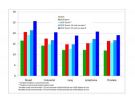(Press-News.org) COLLEGE STATION, Jan. 11, 2011 – Biologists at Texas A&M University have made an important step toward understanding human mating behavior by showing that certain genes become activated in fruit flies when they interact with the opposite sex.
Their research, published in the January 2011 issue of the journal GENETICS, shows that courtship behaviors may be far more influenced by genetics than previously thought. In addition, this new understanding as to why and how these genes become activated within social contexts may also lead to insight into disorders such as autism.
"Be careful who you interact with," said Dr. Ginger E. Carney, associate professor of biology and co-author of the study. "The choice may affect your physiology, behavior and health in unexpected ways."
To make this discovery, Carney and a student in her laboratory, Lisa L. Ellis, compared gene expression profiles in males that courted females, males that interacted with other males and males that did not interact with other flies. The investigators identified a common set of genes that respond to the presence of either sex. They also discovered that there are other genes which are only affected by being placed with members of a particular sex, either male or female. The researchers then tested mutant flies that were missing some of these socially responsive genes and confirmed that these particular genes are important for behavior.
Carney and Ellis predict that analyzing additional similar genes will give further insight into genes and neural signaling pathways that influence reproductive and other behavioral interactions.
"This study shows that we're closing in on the complex genetic machinery that affects social interactions," said Mark Johnston, editor-in-chief of GENETICS. "Once similar genes are identified in humans, the implications will be enormous, as it could bring new understanding of, and perhaps even treatments for, a vast range of disorders related to social behavior."
Carney, who joined the Texas A&M Department of Biology faculty in 2004, earned her Ph.D. in genetics from the University of Georgia in 1998. She held positions as a postdoctoral researcher at Oregon State University (1998-2002) and as a faculty research scientist at Georgia Institute of Technology (2002-2004) prior to coming to Texas A&M, where her research focuses on the fruit fly Drosophila melanogaster and its genetic control of behavior and nervous system development.
Ellis earned her doctorate in biology from Texas A&M in August and now works as a research assistant in the Texas A&M Department of Entomology affiliated with Texas AgriLife Research.
Because fruit flies undergo many of the same developmental processes as larger creatures, including humans, Carney said they serve as model organisms, allowing researchers to observe details that can't necessarily be seen in more complex animals. Through this study and her future research, she hopes to learn more about how individual genes regulate behaviors from mating to central nervous system function in humans.
INFORMATION:
To learn more about Carney and her research, visit http://www.bio.tamu.edu/FACMENU/FACULTY/CarneyG.htm.
For more information on GENETICS, go to http://www.genetics.org.
About Research at Texas A&M University: As one of the world's leading research institutions, Texas A&M is in the vanguard in making significant contributions to the storehouse of knowledge, including that of science and technology. Research conducted at Texas A&M represents an annual investment of more than $630 million, which ranks third nationally for universities without a medical school, and underwrites approximately 3,500 sponsored projects. That research creates new knowledge that provides basic, fundamental and applied contributions resulting in many cases in economic benefits to the state, nation and world.
About GENETICS: Since 1916, GENETICS has covered high quality, original research on a range of topics bearing on inheritance, including population and evolutionary genetics, complex traits, developmental and behavioral genetics, cellular genetics, gene expression, genome integrity and transmission, and genome and systems biology. GENETICS, the peer-reviewed, peer-edited journal of the Genetics Society of America is one of the world's most cited journals in genetics and heredity.
News release includes significant contributions from GENETICS.
Contact: Shana K. Hutchins, (979) 862-1237 or shutchins@science.tamu.edu or Dr. Ginger E. Carney, (979) 845-6587 or gcarney@mail.bio.tamu.edu
For more news about Texas A&M University, go to http://tamunews.tamu.edu.
Follow us on Twitter at http://twitter.com/tamutalk.
GALVESTON, Texas — When most people in the developed world think of measles, what comes to mind is only a dim memory of a vaccination at a pediatrician's office. But while childhood vaccination has virtually eliminated measles from North America and much of Europe, researchers remain interested in the virus.
This fascination persists partly because improving the measles vaccine could help eliminate the more than 10 million measles infections and 150,000 measles-caused deaths that still occur worldwide. But it also has another source: Scientists believe that modified ...
Some disorders of the brain are obvious — the massive death of brain cells after a stroke, the explosion in the growth of cells that marks a tumor. Other disorders, such as autism, schizophrenia and mental retardation show no physical signs of damage and are believed to be caused by problems in how brain cells communicate with one another.
To understand the root of the problem of these latter diseases, visualizing brain activity is key. But even the best imaging devices available — fMRIs and PET scans — can only give a "coarse" picture of brain activity.
UCLA neuroscientists ...
Morgantown, WV, January 11, 2011 – A Blanchette Rockefeller Neurosciences Institute (BRNI) study published today in the Journal of Neuroscience reveals underlying causes for the degeneration of synapses in Alzheimer's Disease and identifies promising pharmaceutical solutions for the devastating condition that affects more than 5 million people in the United States. The BRNI study is the first to achieve fundamental molecular understanding of how synapses are lost in Alzheimer's Disease before the plaques and tangles develop. At the same time, it is the first study to ...
The estimated total cost of cancer care in the United States in 2020 is expected to be $158 billion assuming the most recent observed patterns of incidence, survival, and cost remain the same. This represents a 27% increase from 2010 due only to the projected aging and growth of the US population, according to a study published online January 12th in The Journal of the National Cancer Institute. However, the authors also note the cost of cancer care could rise even more quickly under some reasonable assumptions such as a 2% annual increase in costs of the initial and final ...
Washington, DC – Tinnitus appears to be produced by an unfortunate confluence of structural and functional changes in the brain, say neuroscientists at Georgetown University Medical Center (GUMC).
The phantom ringing sounds heard by about 40 million people in the U.S. today are caused by brains that try, but fail to protect their human hosts against overwhelming auditory stimuli, the researchers say in the January 13th issue of Neuron. They add that the same process may be responsible for chronic pain and other perceptual disorders.
The researchers say that the absence ...
Based on growth and aging of the U.S. population, medical expenditures for cancer in the year 2020 are projected to reach at least $158 billion (in 2010 dollars) – an increase of 27 percent over 2010, according to a National Institutes of Health analysis. If newly developed tools for cancer diagnosis, treatment, and follow-up continue to be more expensive, medical expenditures for cancer could reach as high as $207 billion, said the researchers from the National Cancer Institute (NCI), part of the NIH. The analysis appears online, Jan. 12, 2011, in the Journal of the National ...
(PHILADELPHIA) –The discovery that high levels of high-density lipoprotein (HDL) cholesterol (the "good cholesterol") is associated with reduced risk of cardiovascular disease has fostered intensive research to modify HDL levels for therapeutic gain. However, recent findings have called into question the notion that pharmacologic increases in HDL cholesterol levels are necessarily beneficial to patients. Now, a new study from researchers at the University of Pennsylvania School of Medicine shows that a different metric, a measure of HDL function called cholesterol efflux ...
A new study identifies a molecule that is a critical regulator of neuron survival after ischemic brain injury. The research, published by Cell Press in the January 13 issue of the journal Neuron, may lead to new therapies that reduce damage after a stroke or other injuries that involve an interruption in blood supply to the brain.
Ischemic brain injury is damage caused by a restriction in blood supply. Neuronal death after an interruption in the supply of oxygen and glucose involves a complex cascade of pathological events and, although previous research has identified ...
NIH-funded researchers were able to eliminate tinnitus in a group of rats by stimulating a nerve in the neck while simultaneously playing a variety of sound tones over an extended period of time, says a study published today in the advance online publication of the journal Nature. The hallmark of tinnitus is often a persistent ringing in the ears that is annoying for some, debilitating for others, and currently incurable. Similar to pressing a reset button in the brain, this new therapy was found to help retrain the part of the brain that interprets sound so that errant ...
SEATTLE – Astronomers who survey galaxies in the distant universe are getting some unexpected help from gravity, according to a new study.
In a presentation at the American Astronomical Society meeting this week and a related paper in the current issue of the journal Nature, researchers say that as many as 20 percent of the most distant galaxies currently detected appear brighter than they actually are, because of an effect called "strong gravitational lensing."
The discovery could change astronomers' notions of how galaxies formed in the early universe.
Haojing Yan, ...

